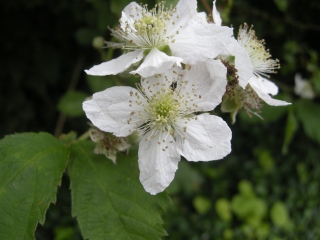Position: Full sun to shade
Flowering period: Late spring early summer
Soil: Well drained
Eventual Height: 3m
Eventual Spread: 8m
Hardiness: 3a, 3b, 4a, 4b, 5a, 5b, 6a, 6b, 7a, 7b, 8a, 8b, 9a
Family: Rosaceae
Rubus fruticosus is a vigorous deciduous/ evergreen perennial shrub growing up to 3m tall. The plant has arching, sharp prickly canes which it uses to scramble over other plants, these canes are typically biennial. The new canes produce vegetative growth only for their first year, these are called primocanes . In the second year these canes then produce flowering laterals and are called floricanes. The The roots are perennial and spread readily by underground runners. The leaves are simple, lobed, palmate or pinnate. Hermaphrodite flowers are produced in late spring to early summer in short racemes on the tips of the flowering laterals. Each flower is about 2-3cm in diameter with five white or pink petals. These are followed by edible aggregate fruit composed of small drupelets.
Rubus fruticosus, commonly known as the Blackberry or Bramble, is a well known group of 375 species native throughout the temperate northern hemisphere and South America. In some countries such as New Zealand, Chile, Australia and the Pacific Northwest region of North America some Blackberry species are considered a serious weed and are naturalized. In the UK folklore holds that Blackberries should not be picked after Old Michaelmas Day as the devil has claimed them leaving a mark on the leaves.
The etymological root of the binomial name Rubus is derived from the old Roman name for this plant. Fruticosus is derived from the Latin meaning shrubby.
The landscape architect may specify Rubus fruticosus as part of a woodland planting scheme, forming one of the components of the ground flora. It may also be useful as part of a wildlife scheme, although consideration should be given too the maintenance requirements of this plant to keep it in check. Cultivated varieties of this plant may be specified as part of a community garden project.
Ecologically, Rubus fruticosus provides food a variety of insects, mammals and birds. Caterpillars will feed on it’s leaves, some mammals will graze on its leaves and birds will feed on its fruit. This plant also provides valuable cover for nesting birds.
Rubus fruticosus prefers fertile well drained soils. It will thrive in all soil structures and all typical soil pH.. It will thrive in nutrient poor soils.
The Royal Horticultural Society has given the varieties ‘Fantasia’ (1993), ‘Loch Ness’ (1993) and ‘Silvan’ (1994) their prestigious Award of Garden Merit.
Rubus fruticosus requires little maintenance. If stands of this shrub are spreading beyond their desired location it may be kept in check by digging up the root and runners or treating with a translocated herbicide.






